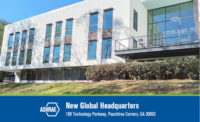There’s a lot that goes into engineering a 21st century commercial office, especially one in a circa 1970s, super-tall building like Chicago’s Willis Tower.
Designing MEP systems for clients in Willis and beyond over the last 50 years has taught ESD a thing or two about commercial offices. So, when it was time to design our own office in Willis, we drew from our toolkit of lessons learned. As it turns out, we had the same goals as many of our clients. Like them, we also sought to create an environment that would:
-
Help us retain and attract employees — We did this by integrating smart systems and designing sustainably;
-
Foster innovation and create opportunities for learning — We leveraged our vendor relationships to include a variety of manufacturers and their products in the space; and
-
Deliver within budget — With some creative engineering and help from our vendor partners, we came in under budget.
A Living Lab
Engineers are constantly reevaluating MEP systems, technologies, and design sequences to inform the design of new spaces. At its new Willis Tower office, ESD chose to employ many of the current, potential, and newly available solutions from our partnering vendors and clients to “try them out” in real time. By doing so, we’re effectively comparing them to each other while using them as teaching tools for the firm’s junior engineers. Thanks to this equipment and some creative engineering, ESD’s Willis Tower office, which opened its doors in April, is on track to earn LEED, v4 Silver certification as well as FitWel 2-star certification.
Here are some of the strategies we employed to achieve these goals:
Hybrid HVAC System
The Willis Tower building perimeter is served by legacy induction units that take up space along each perimeter wall. ESD has consulted with the building owners regarding alternate options to serve the perimeter with a goal of maximizing office floor space. In the past, the building tried chilled beams as a replacement for the induction units, but as a singular approach to heating and cooling in a building with single-pane glass, they didn’t prove to be effective enough.
For ESD’s offices, we took a hybrid approach, which utilized the building’s existing perimeter ventilation system in combination with overhead fan coil units. Installing two fan coils with distributed ductwork and slot diffusers brought the main job of heating/cooling to the ceiling and helped push the air down across the length of the tower’s single-pane glass. We removed the original induction units along one perimeter wall of the office with the existing ventilation air still coming from the floor through a built-up knee wall with a continuous slot along the glass.
In an effort to compare approaches and performance, installation was limited to one perimeter wall. By doing this, the office gained 8 inches of usable space in each window bay across one wall, or approximately 37 square feet in total. Had the induction units been removed across the entire office floor, the gain would be approximately 442 square feet of usable space. Since move in, we have found the fan coil solution to be slightly quieter than the existing induction units, and the space temperature set points have been maintained — keeping the occupants in this area comfortable.
While this hybrid system comes at a cost, its benefit is additional usable square footage, a marketplace advantage for buildings catering to all tenants. Performance-wise, there are no significant efficiencies to be gained (possibly minor ones), but comfort is an added bonus.
Since employing this strategy in our office, we have worked with Willis Tower to show a proof case to end users on other floors as a way to negotiate leasing.
Server Room Containment
To cool the ESD Willis Tower server room, data center best practices were employed from ESD’s mission critical group. Employing a hot aisle containment system for the small 528-square-foot server room provided both cost and energy savings.
The containment strategy saves space by featuring a small, hot aisle at the back of the servers, contained so as not to mix with the cold inlet side. This ensures that all the hot air coming off the back of the servers (85º-90ºF) doesn’t mix with the ambient inlet air maintained at 72º. Once the hot air leaves the back of the servers, it is cooled by in-row air conditioning units to maintain the cold aisle temperature at the front end.
While a containment system isn’t unique, its application at ESD is. Partnering with ESD vendors, five different manufacturers of server cabinets in two different colors with three different kinds of doors were installed. This allows ESD to compare and contrast different cabinet manufacturers and styles and how each facilitates the containment strategy.
Building Intelligence
In order to be fit for the future, ESD’s Willis Tower office is the first to benefit from the firm’s new cloud-based intelligent building platform. Focused on enhancing the occupant experience while improving system performance, ESD’s IB platform tracks energy data gathered in real time, bringing systems controls together to meet energy performance goals. On the front end, employees will be able to access the office, control the utilities in their workspace, book building amenities, and more — all from their computers or mobile phone apps.
The platform integrates the lighting systems, electrical distribution, HVAC equipment, and more with sensors installed wherever possible — at each desk, in most light fixtures — to gather granular data. This data will help ESD develop and pilot new software features and sequences of operation to enhance employee, equipment, and space productivity.
Rolling the IB platform out at the firm’s office affords ESD the opportunity to test it, make changes as necessary, and demonstrate its features to clients in real time. From initial energy models, it was expected that the integrated system would provide a 20 percent improvement over energy usage from the previous office and a 30 percent improvement from month to month. However, based on current performance, we now expect these numbers to be even higher. Eventually, the data gathered will be used to set back the a/c in empty rooms, share performance information widely across the company to encourage behavioral change, and allow mechanical designers to look through the data to ultimately make informed infrastructure and systems changes.
Consider conference room use in the office, for example. The new IB platform helps inform room usage and utilization rates, lighting and daylighting requirements, HVAC occupancy levels, and more. Here’s how:
Space utilization. In ESD’s previous office, conference room space was at a premium. Therefore, when designing the Willis Tower office, additional smaller meeting rooms were included. Data from the last two months of conference room usage reveals that meeting spaces are actually underutilized in the new office. While usage is at 33 percent, initial conference room bookings were much higher. Comparing utilization data of big versus small conference rooms and huddle spaces will inform ESD’s decision whether to repurpose conference rooms down the road.
Tablet signage in the front of each conference room indicates room availability. If there’s a reoccurring meeting scheduled and no one shows up for three meetings in a row, for example, the IB platform can cancel the entire meeting series. While this may not have a significant impact on the HVAC system, it will impact space utilization. The data might be used to conclude that a particular conference room is underutilized and should be repurposed as something else — a new office, storage room, etc.
Lighting controls. The system that manages the office’s room reservations is connected to the lighting control system so that lighting sensors detect if the room is empty. If a meeting is supposed to start but no one shows up after 15 minutes, the system is programmed to cancel the meeting and remove the reservation so others can book it. Similarly, the lighting system also directly connects the server to the conference room system. The lighting control has an on-premise gateway to gather performance data. Meters track how well daylight is working over time and how many kilowatt hours are saved.
Ultimately, the goal of the IB platform is to allow ESD to facilitate visitor management, use cellphones as a credential for entering and existing the office, enter service requests if something is broken, and more.
Lighting Integration
ESD’s LED lighting control system features sensors in each fixture with integral Bluetooth beacons in the Willis Tower office. Together, they can sense an array of motion, light, and temperature, including discerning the motion pattern of a person, including where they are in the room.
The office’s digital, addressable lighting control system features high-density sensors and granular controls in many cases down to the individual fixture. Responsive daylight dimming is accomplished by dimming the first 4-foot fixture more than the next fixture as occupants move further into the room.
In just the first two months at the new Willis Tower office, it was determined that occupants — across the office at each desk — were getting acceptable lighting levels at 60 percent illumination. Thanks to the digital, addressable controls in each fixture, we’ve been able to trim all fixtures down to 60 percent, resulting in an immediate 40 percent operational energy savings over design.
Electrical Submetering
In addition to the very granular per-fixture and per-area energy measurements available from our lighting control system, ESD installed electrical submeters into our own tenant space to measure 100 percent of our plug, IT, and supplemental HVAC loads. The wealth of energy data is connected to digital signage and dashboards to display our usage patterns to occupants in real time.
Using the Living Lab to Inform the Future
From electrical metering to server room containment, intelligent building programs, lighting controls, HVAC systems, and more, we’re effectively taking a third-party look at ourselves as the tenant: How do we perform? Where are we lean? How can we improve efficiency?
Our data collection is ongoing, and the ESD team is watching power consumption across the server room while also monitoring our HVAC supplemental units and taking note of how they’re performing, determining whether or not it is in line with our energy model. Collective energy use in such granularity opens the door to a wealth of new opportunities in efficiency and operations.






